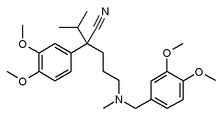The Controlled Onset Verapamil Investigation of Cardiovascular End Points (CONVINCE) trial was planned to establish the effectiveness of controlled-onset extended-release (COER) verapamil with standard therapy in preventing cardiovascular disease end points. The trial was stopped two years early because the sponsor withdrew financial support.
CONVINCE was a large, randomized, double-blind, controlled, multicenter, international trial comparing COER verapamil with hydrochlorothiazide or atenolol. Primary end points included stroke, acute myocardial infarction, or cardiovascular-disease--related death. Secondary end points included heart failure, transient ischemic attack or carotid endarterectomy, hospitalization for angina, cardiac revascularization or transplant, renal failure, malignant hypertension, all-cause mortality, cancer, and hospitalization for bleeding (excluding hemorrhagic stroke).
The sample size was increased during the course of the trial to 16,600, with a target of 2,246 events after researchers realized that the withdrawal rate from verapamil was greater than initial estimates. Equivalence bounds for the hazard ratio were prespecified as 0.86 to 1.16. In patients not achieving adequate blood pressure control, the dosage could be increased, or hydrochlorothiazide or atenolol could be added to the assigned regimens in a blinded fashion. A third antihypertensive medication from another class could be added in a nonblinded fashion.
Over the mean 2.2 years of the study period, both regimens lowered blood pressure significantly. On average, systolic blood pressure was reduced by 13.6 mm Hg and diastolic pressure by 7.8 mm Hg from baseline in patients receiving COER verapamil. In those receiving atenolol or hydrochlorothiazide, systolic and diastolic blood pressures were reduced by 13.5 mm Hg and 7.1 mm Hg, respectively. Differences in both systolic and diastolic pressures between the two arms were small.
In the COER verapamil group, there were 364 first primary end points, and in the atenolol or hydrochlorothiazide group there were 365. The composite primary end point hazard ratio for the COER verapamil group compared with the atenolol or hydrochlorothiazide group was 1.02 (confidence interval, 95 percent). The hazard ratio for the primary end point or cardiovascular-related hospitalization was 1.05, and for death, 1.08. Treatment hazard ratios were similar between both groups in terms of the time of day in which events occurred. In both groups, there was a predominance of primary events in the period between 6 a.m. and noon.
The results of this study show that COER verapamil is not equivalent to atenolol or hydrochlorothiazide in preventing cardiovascular disease--related events. Because the trial was stopped early, fewer than one third of the planned number of events were observed. In the context of other trials, such as the Antihypertensive and Lipid-Lowering Treatment to Prevent Heart Attack Trial (ALLHAT), the data indicate that calcium channel blockers are similar to diuretics and beta blockers in reducing cardiovascular-disease--related morbidity and mortality but are not more effective than either.
Caroline Wellbery, M.D.
Black HR, et al. Principal results of the controlled onset verapamil investigation of cardiovascular end points (CONVINCE) trial. JAMA April 23/30, 2003;289:2073-82.
COPYRIGHT 2003 American Academy of Family Physicians
COPYRIGHT 2003 Gale Group



